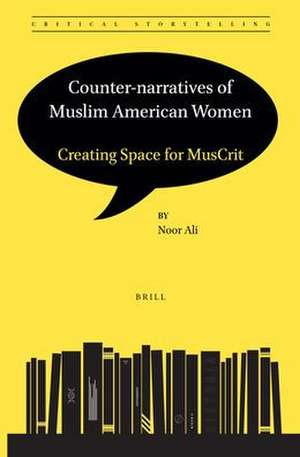Counter-narratives of Muslim American Women: Creating Space for MusCrit: Critical Storytelling, cartea 6
Autor Noor Alien Limba Engleză Paperback – 23 mar 2022
The social and academic learning opportunities showcase instances of both inclusion and marginalization which lead students to experience a double consciousness. What this study ultimately shows is that these students experience the dichotomous pull of religious and cultural values as they navigate their intersectional identities.
Preț: 291.84 lei
Nou
Puncte Express: 438
Preț estimativ în valută:
55.84€ • 57.61$ • 46.60£
55.84€ • 57.61$ • 46.60£
Carte disponibilă
Livrare economică 05-19 martie
Preluare comenzi: 021 569.72.76
Specificații
ISBN-13: 9789004519220
ISBN-10: 900451922X
Dimensiuni: 155 x 235 mm
Greutate: 0.18 kg
Editura: Brill
Colecția Brill
Seria Critical Storytelling
ISBN-10: 900451922X
Dimensiuni: 155 x 235 mm
Greutate: 0.18 kg
Editura: Brill
Colecția Brill
Seria Critical Storytelling
Notă biografică
Noor Ali, EdD (2018), is an Assistant Professor at Northeastern University, a K-8 veteran educator and school leader. She has coined a subset in Critical Race Theory(CRT) called MusCrit. Dr. Ali has extensively published and presented on topics related to CRT, MusCrit, Experiential Learning, Leadership, and Social Justice in Education.
Cuprins
Acknowledgments
Introduction
1 Critical Race Theory and Racialization
2 Tenets & Application of Critical Race Theory
3 Offf-shoots of Critical Race Theory
4 Racialization of Religious Identity
5 From CRT to MusCrit
6 Tenets of MusCrit
7 From Theoretical Framework to Methodology
8 The Use of Narrative Research
9 The Stories Ahead
1 Rahmah’s Story
1 Framing Identity
2 Finding Friends in Diverse Spaces
3 Experience of Demonization
2 Deena’s Story
1 Navigating Identity
2 Treading Carefully
3 Hafsa’s Story
1 Informal & Formal Educational Experiences
2 Difffijiculty in Transition to High School
3 The Strengthening Role of the Community
4 The Role of Parents and Acculturation
5 Defijining American and Intersectionality
6 Connection to Curriculum
7 Interactions with Teachers and Microaggressions
4 Rania’s Story
1 Hijab & Identity
2 Influences on Identity
3 Uncomfortable Interactions
5 Mehar’s Story
1 Relationship with Her Hijab
2 Sense of Community
3 Questions of Identity
4 Early Experiences in America
5 Uncomfortable Interactions
6 Amber’s Story
1 Defijining Self, Race, and Ethnicity
2 Finding Strength in Diversity
3 Parents and Acculturation
4 Values
7 Selma’s Story
1 School
2 Transitioning to College
3 Choosing to Wear the Hijab
8 Rida’s Story
1 The Role of School
2 Defijining Self, Race, and Popular Culture
3 Anxiety about Transitioning to College
4 Impact of Religious Values
5 The Strengthening Role of Family
9 Layla’s Story
1 Navigating Identity
2 Educational Journeys
3 Classroom Conversations
4 Relationship with Hijab
5 Religion as Lifestyle
10 Samreen’s Story
1 Being Impacted: School and Family
2 Being American
3 Uncomfortable Conversations
11 Yasmine’s Story
1 Acculturation
2 Values
3 Curriculum
4 Experience of Demonization
12 Ayesha’s Story
1 Influence of School
2 Values Shaped in the Home
3 College Experience
4 Defending the Faith
13 Fatima’s Story
1 Culture & Identity
2 Identity & Educational Experience
3 Diminishing Experiences
14 Sana’s Story
1 Critical Conversations & Representing Islam
2 Extra-curriculars and Identity
3 Being Enough
15 Farah’s Story
1 Impact of Culture and Faith
2 Learning from School
3 Discussing 9/11
4 Contemplating Identity
MusCrit in Action
Conclusion
References
Index
Introduction
1 Critical Race Theory and Racialization
2 Tenets & Application of Critical Race Theory
3 Offf-shoots of Critical Race Theory
4 Racialization of Religious Identity
5 From CRT to MusCrit
6 Tenets of MusCrit
7 From Theoretical Framework to Methodology
8 The Use of Narrative Research
9 The Stories Ahead
1 Rahmah’s Story
1 Framing Identity
2 Finding Friends in Diverse Spaces
3 Experience of Demonization
2 Deena’s Story
1 Navigating Identity
2 Treading Carefully
3 Hafsa’s Story
1 Informal & Formal Educational Experiences
2 Difffijiculty in Transition to High School
3 The Strengthening Role of the Community
4 The Role of Parents and Acculturation
5 Defijining American and Intersectionality
6 Connection to Curriculum
7 Interactions with Teachers and Microaggressions
4 Rania’s Story
1 Hijab & Identity
2 Influences on Identity
3 Uncomfortable Interactions
5 Mehar’s Story
1 Relationship with Her Hijab
2 Sense of Community
3 Questions of Identity
4 Early Experiences in America
5 Uncomfortable Interactions
6 Amber’s Story
1 Defijining Self, Race, and Ethnicity
2 Finding Strength in Diversity
3 Parents and Acculturation
4 Values
7 Selma’s Story
1 School
2 Transitioning to College
3 Choosing to Wear the Hijab
8 Rida’s Story
1 The Role of School
2 Defijining Self, Race, and Popular Culture
3 Anxiety about Transitioning to College
4 Impact of Religious Values
5 The Strengthening Role of Family
9 Layla’s Story
1 Navigating Identity
2 Educational Journeys
3 Classroom Conversations
4 Relationship with Hijab
5 Religion as Lifestyle
10 Samreen’s Story
1 Being Impacted: School and Family
2 Being American
3 Uncomfortable Conversations
11 Yasmine’s Story
1 Acculturation
2 Values
3 Curriculum
4 Experience of Demonization
12 Ayesha’s Story
1 Influence of School
2 Values Shaped in the Home
3 College Experience
4 Defending the Faith
13 Fatima’s Story
1 Culture & Identity
2 Identity & Educational Experience
3 Diminishing Experiences
14 Sana’s Story
1 Critical Conversations & Representing Islam
2 Extra-curriculars and Identity
3 Being Enough
15 Farah’s Story
1 Impact of Culture and Faith
2 Learning from School
3 Discussing 9/11
4 Contemplating Identity
MusCrit in Action
Conclusion
References
Index









